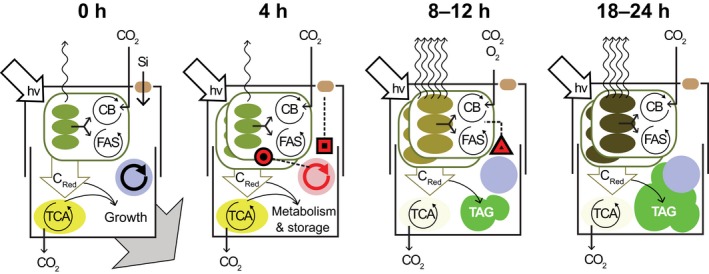Figure 9.

Conceptual overview summarizing major changes in carbon and energy flux, and putative regulatory events in silicon‐starved Thalassiosira pseudonana (experiments Si– #1–8) at 0, 4, 8–12, and 18–24 h. At 0 h, light absorption, carbon fixation, and respiration are in balance for growth, and silicon transporters sense silicic acid. Transcription in the nucleus (blue) is regulated by cell cycle progression, and light energy lost via nonphotochemical quench (NPQ, wavy arrow) is low. At 4 h, cells sense reduced silicon availability and signal the nucleus through a putative silicon detection mechanism (black and red box; Fig. S3). Growth is arrested, but cell cycle proceeds partially and signals chloroplast replication (black and red circle). At 8–12 h, pigment composition has shifted towards an increased proportion of photoprotective pigments, and the de‐epoxidation state (DES) has increased, indicating an increase in loss of light energy through NPQ. A decrease in cellular cAMP concentrations (mediated by low CO 2) signals increased transcription of photorespiration/carbon concentrating/ACCasechl (black and red triangle). Flux of carbon towards the tricarboxylic acid (TCA) cycle is down‐regulated and triacylglycerol (TAG) droplets form. By 18–24 h, chloroplasts have become more heavily pigmented and have remodeled to increase NPQ, cell cycle is completely arrested, and cells continue to accumulate TAG droplets. CB, Calvin–Benson; FAS, fatty acid synthesis; C Red, reduced carbon.
